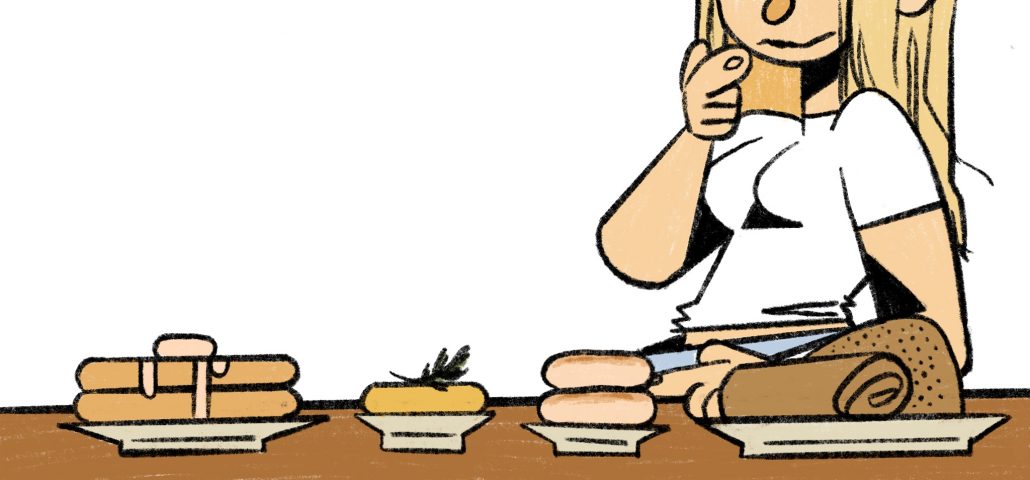Eating L.A. Before it Eats Itself: Americans aren’t the only ones acing the pancake game

Pancakes are an inevitable facet of any functioning society. Before noodles were crafted out of flour and starch, before bread was baked fresh in ovens, before rice was tenderly dried and boiled, there was the pancake. The mummified stomach of 5,300- year-old Otzi the Iceman was filled with pancakes. Unlike other carbohydrates that needed to be baked and processed, the pancake was simple — pan-fried, versatile, incredibly easy to make.
Pancakes were the first food I ever learned to make. Too small to see the pancakes bubble and crisp at my own height, I stood on a kitchen chair, staring down at the stove. I dressed them in gooey, grocery store syrup and margarine, sometimes with fruit, sometimes with chocolate.
Like many Americans, my first and only conception of pancakes was of the sweet kind. It wasn’t until I started living in Los Angeles that I realized my understanding of pancakes was incredibly limited. In fact, pancakes can be found across dozens of cuisines in varying forms and flavors. All of them I love. All of them I rely on for the most basic sense of comfort, the simplest kind of happiness.
Here are some of my favorites:
Traditional American Pancakes
Sometimes, I just want to press them to my face and inhale that sweet, warm flour smell, steam and butter deep in my pores, buried under a blanket and safe from the world. I was raised on these, and sometimes a plate of well-made pancakes was the closest thing to home all week.
Most pancakes in America, from diners to breakfast cafes to fancy brunches, are bound by their sweetness. Served with syrup and butter, sometimes with a scattering of fruit or chocolate, pancakes have fallen into a comfortable monotony. The recipe to American pancakes hardly changes, but when it does, it’s noticeable. My favorite American pancakes in Los Angeles are from The Original Pantry Cafe, which spikes each batch with a healthy dose of sugar and butter within the batter. They weigh about three pounds and taste exactly like pound cake. In American pancakes, the only deciding factor in a “good” or “bad” pancake is the recipe used and the preparation. Griddle or pan? It makes a difference.
Korean Jeon
Every week, I pass by the H Mart in Koreatown, and every week, I fall prey to the temptation of pancakes. Eggy and tender, Korean jeon (or buchimgae, or pajeon) spans a variety of styles: kimchi, green onion, crab and pollock are just a few popular in America. Jeon serves not as a breakfast entree but as a side dish as a part of banchan, an elaborate spread of side dishes to accompany a main meal. Jeon, a ubiquitous side, can be found all over Koreatown, especially in Korean BBQ restaurants. In H Mart, they sell several varieties of jeon, made earlier in the day and sealed for casual purchase. Fresher and tastier pancakes can be found at restaurants like Kobawoo House, which serves a fantastic haemul pajeon, a pancake filled with seafood and scallions. Mostly, however, I find myself eating jeon on the street outside of H Mart, still in its packaging. I do not care. It’s delicious anyways.
Chinese Bing
My first experience biting into crispy layers of delicate, onion-infused pastry was almost a religious one. Scallion pancakes are a popular side dish and an essential component of Chinese and Taiwanese cuisine, found lurking under dumplings and rice dishes. Pan-fried and full of flavor, scallion pancakes are an incredible feat and one that I will never fail to order if I find it on the menu.
Unlike American pancakes, cong you bing is delicately fried from a dough instead of a batter, speckled with chunks of green onion. As a result, the scallion pancake is irresistibly crisp and crunchy.
Similar to the Korean jeon, bing encompasses several dishes and preparations of flatbread — jianbing is a large, crepe-like pancake and popular street food, to name another variety. But in my eyes, there is no better bing than the scallion pancake, usually served in neat triangles, sometimes wrapped around pieces of steak in the quintessential Los Angeles beef roll. San Gabriel Valley is flooded with excellent scallion pancakes — Flavor Garden and J & J Restaurant serve two delicious preparations of it. In Silverlake, Pine & Crane serves crispy pancakes and beef rolls under romantic candlelight. There is nothing quite as satisfying as a fresh scallion pancake. It will leave behind onion-scented oil and plenty of crumbs, but it will be worth it.
Ethiopian Injera
A typical display of Ethiopian food embodies a grandeur that is only matched by the table-long dishes of banchan served in Korean restaurants. Typically served on top of a thin, massive sourdough pancake called injera, multiple types of stews and dishes are placed onto one plate alongside extra sheet-like rolls of the pancake.
Popular injera toppings include kitfo, minced raw beef mixed with fragrant clarified butter and spoonfuls of spice; tibs, a sauteéd meat and vegetable mixture and wat, an onion stew with dozens of variations. But in my eyes, the star of the show is always injera. Tangy from the sourdough, soft but just sturdy enough to pick up the thinnest of stews, injera is more than a side dish. It is the utensil, the plate, a prominent flavor, an essential element of Ethiopian cuisine.
Instead of forks and knives, the injera itself is used to pick up its toppings. Its spongy texture soaks up residual sauces, tasting better and better as the meal comes to a close. Try the fantastic Meals by Genet in Little Ethiopia — the injera will change you for the better.
Christina Tiber is a senior writing about food. Her column, “Eating L.A. Before It Eats Itself,” runs every other Thursday.

